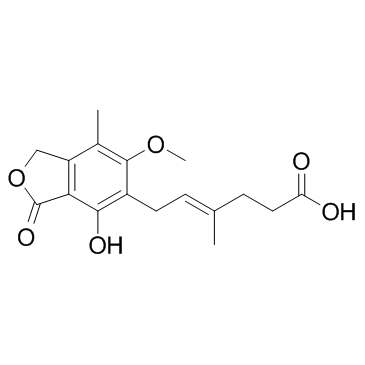Mycophenolic acid

Mycophenolic acid structure
|
Common Name | Mycophenolic acid | ||
|---|---|---|---|---|
| CAS Number | 24280-93-1 | Molecular Weight | 320.337 | |
| Density | 1.3±0.1 g/cm3 | Boiling Point | 611.6±55.0 °C at 760 mmHg | |
| Molecular Formula | C17H20O6 | Melting Point | 141°C | |
| MSDS | Chinese USA | Flash Point | 225.8±25.0 °C | |
| Symbol |



GHS07, GHS08, GHS09 |
Signal Word | Danger | |
|
A nicotinic receptor-mediated anti-inflammatory effect of the flavonoid rhamnetin in BV2 microglia.
Fitoterapia 98 , 11-21, (2014) The alpha7 nicotinic acetylcholine receptor (nAChR) is a potential target in neuroinflammation. Screening a plant extract library identified Solidago nemoralis as containing methyl-quercetin derivatives that are relatively selective ligands for the alpha7 nAC... |
|
|
Cheminformatics analysis of assertions mined from literature that describe drug-induced liver injury in different species.
Chem. Res. Toxicol. 23 , 171-83, (2010) Drug-induced liver injury is one of the main causes of drug attrition. The ability to predict the liver effects of drug candidates from their chemical structures is critical to help guide experimental drug discovery projects toward safer medicines. In this st... |
|
|
Translating clinical findings into knowledge in drug safety evaluation--drug induced liver injury prediction system (DILIps).
J. Sci. Ind. Res. 65(10) , 808, (2006) Drug-induced liver injury (DILI) is a significant concern in drug development due to the poor concordance between preclinical and clinical findings of liver toxicity. We hypothesized that the DILI types (hepatotoxic side effects) seen in the clinic can be tra... |
|
|
Profiling the role of deacylation-reacylation in the lymphatic transport of a triglyceride-mimetic prodrug.
Pharm. Res. 32(5) , 1830-44, (2015) Recent studies have demonstrated the potential for a triglyceride (TG) mimetic prodrug to promote the delivery of mycophenolic acid (MPA) to the lymphatic system. Here, the metabolic pathways that facilitate the lymphatic transport of the TG prodrug (1,3-dipa... |
|
|
Toxicity induced by F. poae-contaminated feed and the protective effect of Montmorillonite supplementation in broilers.
Food Chem. Toxicol. 74 , 120-30, (2014) The T-2 and HT-2 toxins, the main metabolites of Fusarium poae, induce toxicity in broilers and accumulate in tissues. Consequently, during the breeding process of broilers, diets are frequently supplemented with physical adsorbents to protect birds against t... |
|
|
Safety and efficacy of the early introduction of everolimus with reduced-exposure cyclosporine a in de novo kidney recipients.
Transplantation 99(1) , 180-6, (2015) Everolimus and cyclosporine A (CsA) exhibit synergistic immunosuppressive activity when used in combination. We examined the safety and efficacy of the use of everolimus with a cyclosporine-sparing strategy in de novo renal transplant recipients.A comparative... |
|
|
Renal glucuronidation and multidrug resistance protein 2-/ multidrug resistance protein 4-mediated efflux of mycophenolic acid: interaction with cyclosporine and tacrolimus.
Transl. Res. 164(1) , 46-56, (2014) Mycophenolic acid (MPA) is an immunosuppressant used in transplant rejection, often in combination with cyclosporine (CsA) and tacrolimus (Tac). The drug is cleared predominantly via the kidneys, and 95% of the administered dose appears in urine as 7-hydroxy ... |
|
|
Successful treatment of severe myasthenia gravis developed after allogeneic hematopoietic stem cell transplantation with plasma exchange and rituximab.
Pediatr. Blood Cancer 61(5) , 928-30, (2014) Myasthenia gravis is among the rare complications after allogeneic hematopoietic stem cell transplantation and is usually associated with chronic GVHD. Herein, we report a 2-year and 10 months of age female with Griscelli syndrome, who developed severe myasth... |
|
|
Immunosuppressive compounds exhibit particular effects on functional properties of human anti-Aspergillus Th1 cells.
Infect. Immun. 82(6) , 2649-56, (2014) Allogeneic hematopoietic stem cell transplant (HSCT) recipients are at high risk for invasive aspergillosis. Whereas adoptive immunotherapy transferring donor-derived anti-Aspergillus TH1 cells has been shown to be beneficial for HSCT recipients suffering fro... |
|
|
Cytomegalovirus retinitis: a rare but preventable cause of blindness in dermatology patients.
J. Cutan. Med. Surg. 18(4) , 287-90, (2014) Dermatologists are using an increasing range of immunomodulatory therapies to treat an expanding number of skin diseases. Complications of therapy are broad and include infection. Cytomegalovirus (CMV) retinitis has not been reported in association with derma... |